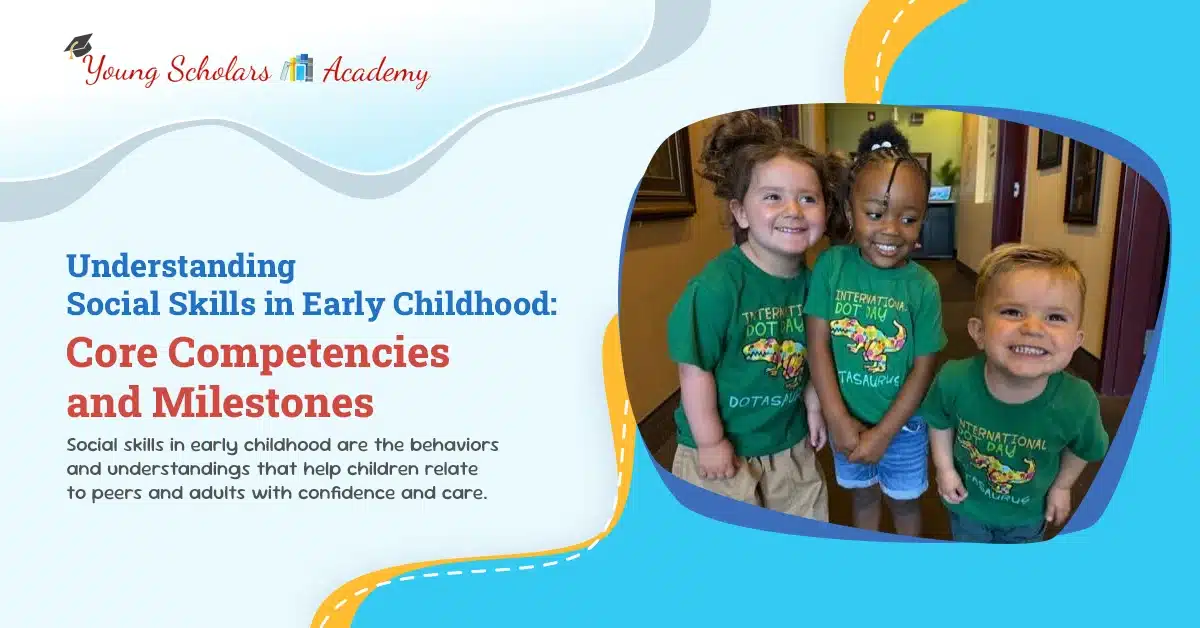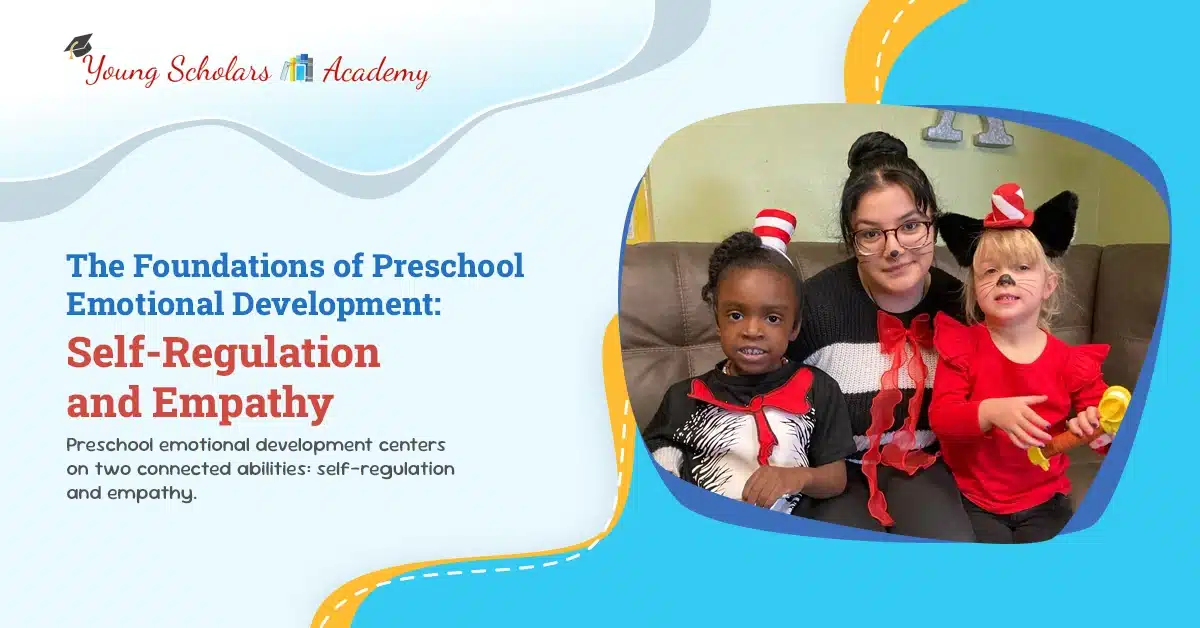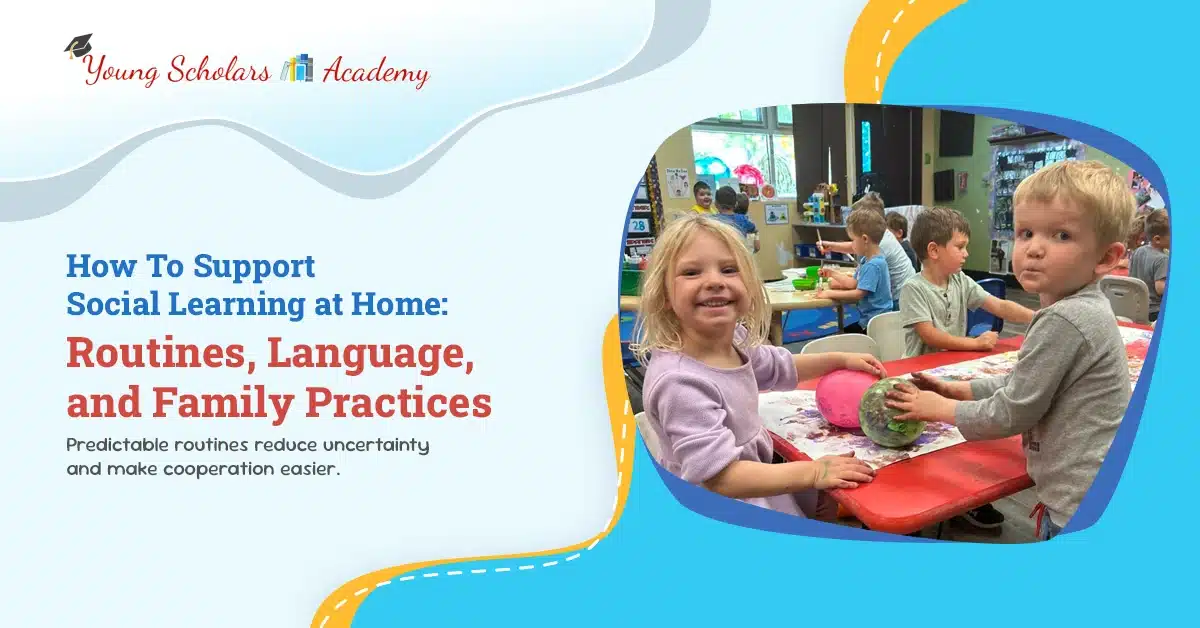Social-emotional learning preschool in Colorado Springs equips young children with the skills to understand emotions, manage behavior, and build healthy relationships. In the preschool years, these foundations support classroom readiness and long-term well-being. Evidence-aligned SEL emphasizes self-awareness, self-management, social awareness, relationship skills, and responsible decision-making.
Children learn through consistent routines, guided play, and intentional language from trained teachers. Calm-down strategies, problem-solving steps, and cooperative projects become part of the day. Family partnerships and regular communication reinforce progress at home. This guide outlines how SEL works in high-quality classrooms, the benefits families can expect, and ways to evaluate a program’s approach for your child.
Understanding Social Skills in Early Childhood: Core Competencies and Milestones
Social skills in early childhood are the behaviors and understandings that help children relate to peers and adults with confidence and care. They include managing impulses, noticing others’ needs, and using language to solve problems. Strong social skills support classroom participation, smooth transitions, and a positive sense of self.
Sharing and Turn-Taking; Cooperation and Conflict Resolution
- Children practice sharing and turn-taking through guided play, timers, and clear routines that make waiting predictable.
- Cooperation grows when tasks require partnership—for example, building together, cleaning up by roles, or completing a group art piece.
- For conflict resolution, teachers model calm words, offer feeling labels, and coach simple steps: state the problem, name feelings, suggest solutions, agree on a plan, and check in afterward.
Perspective-Taking and Communication Skills
- Perspective-taking develops as children learn that others may think, feel, or want something different. Stories, puppets, and role-play invite children to consider multiple viewpoints.
- Communication skills include using “I” statements, requesting help, and reading nonverbal cues such as facial expressions and personal space. Visual supports, sentence starters, and picture cards make expectations concrete and inclusive.
Typical Milestones for Ages 3–5 and Red Flags to Watch
- Age 3
-
-
- Begins parallel play, shifting into brief cooperative moments
- Uses simple phrases to request, refuse, or greet
- Accepts adult help to calm and rejoin play
-
- Age 4
-
-
- Plays in small groups with shared goals
- Identifies basic emotions in self and others
- Tries simple solutions before seeking an adult
-
- Age 5
-
- Negotiates roles, rules, and turn order with minimal support
- Uses feeling words with growing accuracy and empathy
- Recovers from disappointments and returns to tasks
Red flags that may warrant further discussion with teachers or specialists:
- Persistent aggression, frequent isolation, or inability to join play
- Limited eye contact or minimal response to name and social cues
- Very limited emotion vocabulary or intense, prolonged distress that does not improve with support
A thoughtful, consistent approach to these competencies builds a stable foundation for healthy relationships, learning engagement, and kindergarten readiness.
The Foundations of Preschool Emotional Development: Self-Regulation and Empathy
Preschool emotional development centers on two connected abilities: self-regulation and empathy. Self-regulation helps children identify feelings, pause, and choose a constructive response. Empathy helps children notice others’ emotions and act with care. These capacities support learning, cooperation, and a calm classroom climate.
Naming Feelings and Building Emotion Vocabulary
A precise vocabulary of feelings turns big emotions into manageable information. Teachers model accurate words and give children structured language to express needs and set boundaries. Common tools include:
- Visual feelings charts and mirrors for matching expressions
- Sentence frames: “I feel ___ when ___; I need ___”
- Storybooks and puppets that label emotions and solutions
- Check-ins during arrival, transitions, and closing circles
Progress looks like: identifying basic feelings (happy, sad, mad, scared), using words before using hands, and pairing physical cues (tight tummy, fast breathing) with strategies that help.
Co-Regulation Strategies That Lead to Self-Regulation
Young children borrow an adult’s calm before they can create their own. Predictable routines and warm, steady responses teach the brain and body how to settle. Effective practices include:
- Visual schedules, timers, and first-then cards to reduce uncertainty
- Breathing prompts, muscle squeezes, and movement breaks
- Cozy corners with sensory tools, books, and cue cards
- Brief coaching: notice → name → need → next step
Over time, guidance fades as children initiate strategies independently, move from adult-led reminders to self-talk, and return to play more quickly after upsets.
Empathy, Kindness, and Prosocial Behavior in Group Settings
Empathy grows through daily opportunities to see from another perspective and to repair harm. Classrooms embed kindness into routines:
- Partner tasks, classroom jobs, and collaborative centers
- “Stop, name, repair” after conflicts, including a choice of fix-it actions
- Role-play for reading faces, tone, and personal space
- Gratitude and compliments that recognize specific efforts
Growth indicators include offering comfort, waiting for a turn without prompts, and proposing fair solutions. When self-regulation and empathy develop together, children experience smoother peer interactions, stronger teacher relationships, and greater readiness for the demands of kindergarten and beyond. Consistency between home and school further strengthens these outcomes.
How To Support Social Learning at Home: Routines, Language, and Family Practices
Predictable routines reduce uncertainty and make cooperation easier. Use visual schedules for mornings, after-school transitions, and bedtime. Provide warnings before changes. Try first–then cards (“First shoes, then car”) and brief timers for turn-taking. Assign simple family jobs—setting napkins, feeding a pet, watering plants—to practice responsibility and teamwork. End tasks with a consistent “all done” signal so children know what comes next.
Intentional Language and Emotion Coaching
Clear, calm language guides social choices. Narrate what you notice, name the feeling, and identify the need: “You wanted the red truck; you feel frustrated; you can ask for a turn.” Offer sentence starters and keep phrases short:
- “I feel… I need…”
- “Can I have a turn when you are done?”
- “Let’s solve the problem together.”
Use respectful limits with choices: “Blocks stay on the mat. You may build here or start with books.” This structure shows how to support social learning at home while preserving safety and dignity.
Play and Practice: Small, Daily Rehearsals
Social skills grow through repeated, low-stakes practice. Build these into everyday play:
- Cooperative games that require planning and turn-taking
- Role-play to practice greeting, inviting, and declining politely
- Storytelling that pauses to predict feelings and solutions
- Shared chores such as sorting laundry or cooking simple snacks, with roles that rotate
Keep sessions brief and end while interest remains high.
Calm-Down Tools and Spaces
Create a small, inviting corner with a soft seat, books, and sensory tools such as a stress ball or a picture fan of breathing strategies. Teach the steps when everyone is calm: stop, breathe, name the feeling, choose a tool, and rejoin. Model use yourself so the space feels supportive rather than punitive.
Partnering With School for Consistency
Align home routines with classroom strategies. Ask teachers which cues, visuals, and scripts they use, and mirror those at home. Share what works for your child, and review progress during conferences or check-ins. Consistent language and expectations across settings help children generalize skills, leading to smoother peer interactions, faster recovery after conflicts, and growing confidence in social situations.
What Social-Emotional Learning Is: The Five Competencies in Preschool
Social-emotional learning in preschool is a structured framework that builds five connected competencies through daily routines, play, and guided reflection. Children learn skills explicitly, practice them with peers, and receive steady feedback from trained teachers.
Self-Awareness
Children learn to notice and name their feelings, preferences, and strengths. Teachers use mirrors, feelings charts, and short check-ins to connect body cues with emotion words. Simple reflections—”My heart is fast; I feel angry”—help children recognize triggers and celebrate growth. Progress indicators include using accurate feeling words, describing what helps, and expressing pride in effort.
Self-Management
Self-management is the ability to pause, choose a strategy, and return to learning. Classrooms provide visual schedules, first–then cards, and timers to make expectations predictable. Children practice breathing, counting, wall push-ups, or asking for a break. Over time, guidance fades as children initiate strategies, tolerate brief frustration, and rejoin group activities after upsets.
Social Awareness
Social awareness develops as children understand that others have thoughts, needs, and cultures that may differ from their own. Teachers model respectful language, read diverse stories, and use puppets to explore multiple viewpoints. Growth appears when children recognize a peer’s feeling, adjust voice and space, and include others in play, especially new or hesitant classmates.
Relationship Skills
Relationship skills include communication, cooperation, and conflict resolution. Classrooms embed these through:
- Turn-taking games and partner jobs
- Sentence starters: “Can I have a turn when you are done?”
- Peer mediation steps: state the problem, name feelings, suggest solutions, and agree on a plan
Children show progress when negotiating roles, inviting others into play, and repairing small harms with sincere words or fix-it actions.
Responsible Decision-Making
Children learn to consider safety, fairness, and consequences. Teachers use simple decision charts (“What is the problem? What are our choices? What will happen next?”), Think-aloud modeling and pretend scenarios to weigh options. Indicators include choosing safe tools, following class agreements, and predicting outcomes before acting.
When these five competencies are taught consistently, children experience calmer transitions, stronger peer relationships, and growing independence. The result is a secure foundation for learning and a confident step toward kindergarten readiness.
Conclusion
A strong social-emotional foundation in preschool supports every part of a child’s day—learning, friendships, and healthy independence. Children build steady self-regulation and genuine empathy when classrooms teach the five competencies with intention and families reinforce routines and language at home. Milestones become clearer, conflicts resolve more smoothly, and confidence grows as children practice turn-taking, perspective-taking, and responsible choices. In high-quality programs, these gains are visible in daily routines, calm transitions, and respectful peer interactions. For families seeking a social-emotional learning preschool in Colorado Springs, look for consistent strategies, clear communication, and environments designed for practice and reflection.
Connect with our team to discuss your child’s next steps: (719) 522-9099, https://youngscholarsacademycolorado.com/contact-us/.



Leave a Reply